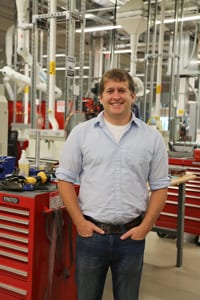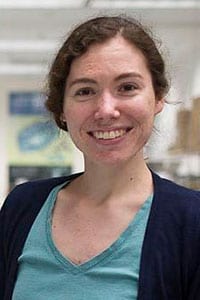Scientists across the globe are rapidly applying technology and methods to answer COVID-19 questions, and many of them have never studied viruses before now.
As the pandemic unfolded, working with their teams, these scientists identified opportunities to contribute to the scientific knowledge around COVID-19 and the virus that causes it, SARS-CoV-2.
John Brubacher, Anthony Gitter, Brian Bockelman, Ben Cox and Katie Overmyer, joined Gabriella Gerhardt on July 22 for a Fearless Science webinar about seizing the moment. The following highlights are some of the key takeaways. A recording of the webinar can be viewed in full above.

John Brubacher, visiting assistant scientist in the Phil Newmark Lab, studies planarian flatworms—a tiny, freshwater worm with remarkable regeneration capabilities. Brubacher talked about how he and his colleagues repositioned their research on flatworm nanobodies into understanding SARS-CoV-2.
“Antibodies’ ability to stick to a … particular molecule may seem like a lame superpower, but they play a critical role in our immune system’s ability to neutralize infectious agents. They’ve also become essential tools for researchers studying biological processes at the molecular level.”
“We can use antibodies to detect and locate a specific molecule – for instance, a viral protein – in a biological sample, to purify that molecule, or to alter its function.”
“The antibodies we’re looking to produce, more precisely, are nanobodies … You can think of a nanobody as an antibody pared down to its smallest functional unit.”
“Once we have identified a few promising candidates, we’ll partner with other labs to help us evaluate and develop the nanobodies as research tools, diagnostic aids, or if we’re very lucky, antiviral therapies.”

Anthony Gitter, an investigator in the John W. and Jeanne M. Rowe Center for Research in Virology, specializes in bioinformatics. Gitter shared information about Manubot, new software he co-developed with Daniel Himmelstein, a postdoctoral fellow in Casey Greene’s Lab at the University of Pennsylvania.
Manubot is chronicling pandemic science in real-time and helping dozens of scientists to rapidly assess and review COVID-19 diagnostics and therapeutics.
“We have a very, very fast-moving scientific area…where new literature is appearing daily, so any review becomes stale as soon as a scientist prints it out to read it. One of the solutions to that stale literature review is through a software tool called Manubot, which stands for ‘manuscript robot.’”
“Its main idea is to bring best practices and approaches from software development to scientific writing. One of the great things is that as we have so many authors all working on the same document, the document itself is constantly updated.”
“Whenever somebody visits the manuscript website, they’ll see the latest and greatest version. Authors have joined the project and been writing a lot about COVID-19 vaccines and diagnostics, clinical aspects, basic biology.”
“We’re looking to submit the COVID-19 review to a scientific journal. But what’s really exciting is that our team is going to continue working on the review and the journal has agreed to accept more versions of the Manubot scientific review on COVID-19 diagnostics, as it continues to evolve over the coming months.”

Brian Bockelman, an investigator in Morgridge Core Computation, works on enabling Research Computing across the institute, the University of Wisconsin–Madison, and beyond—in addition to serving as the Technology Area Coordinator for the Open Science Grid, led by Miron Livny.
Bockelman explained the national infrastructure that empowers researchers, clears roadblocks, and enables analysis of enormous datasets so scientists can move quickly on emerging scientific problems like the pandemic.
“A research computing infrastructure allows scientists to harness the power of many computers to tackle a specific problem.”
“Here at Morgridge, we really want to emphasize the scientists should think about the problems they can solve with unlimited computing – think big and tackle some of the big challenges.”
“We really focus on providing the people and the techniques to help them move quickly. The sort of computing infrastructure that’s necessary for research really takes experts – it takes developed software approaches.”
“And when something like a pandemic arises, the computing infrastructure must be in place already. You can’t within a day or two rent a computer scientist. And I think that the research computing infrastructure investment and expertise at Morgridge is something that really sets us apart and allows us to make impact at Morgridge, across the UW–Madison campus and across the nation.”

Ben Cox, a Berbee Walsh Postdoctoral Fellow, works in the Morgridge Fab Lab, an extensive R&D space with capabilities in rapid prototyping and complex fabrication led by Director Kevin Eliceiri. Cox shared how a diverse group of engineers, prototypers and makers at UW–Madison and in the local community are designing tools to aid in health crises like COVID-19.
“The work we do in the lab is designing and fabricating early-stage prototypes of new technology. We work with campus inventors to realize their ideas and then push them forward to patents and publications.”
“Prototyping communities can aid in emergencies like COVID. With a lot of health emergencies, there are massive shortages of equipment and with COVID-19, the big shortage revolved around personal protective equipment or PPE.” “In Madison, the response really started because UW Health realized we could be looking at a potential shortage of PPE. They reached out to the UW Engineering community, and then it grew to the community at large. I can’t really talk about the local effort without mentioning Lennon Rogers. He’s the director of the UW Makerspace and was instrumental in these local efforts. One of the projects he worked on early on was the Badger Shield.”
“We should be proud of Madison because we have a very vibrant prototyping community that responded really quickly and is continuing to work toward alternative solutions for PPE shortages.”

Katie Overmyer, the associate director of Lab for Biomolecular Mass Spectrometry, applies cutting-edge mass spectrometry techniques to answer biological questions. Overmyer shared data from the Coon Lab’s recent collaboration with a Dr. Ariel Jaitovich, a pulmonary critical care physician treating COVID-19 patients at Albany Medical College.
Overmyer and her colleagues are using advanced mass spectrometry technology and a systems biology perspective to distinguish between severe and mild cases of COVID-19. The research is available in a dynamic tool online: https://covid-omics.app
“Mass spectrometry is one of the premier technologies for analyzing proteins, small molecules and lipids. We try to capture all of them through various platforms that we have in the lab.”
“Dr. Jaitovich proposed a study to look at our COVID patients coming through his clinic … He was curious to understand what mechanisms might be underlying the severity of COVID response.”
“The study design was a recruitment of patients with COVID-19 or patients that had symptoms similar to COVID-19 coming through the Albany Medical Center. They donated blood, which was separated for plasma and white blood cells. In total, we measured thousands of molecules, small-molecule metabolites, lipids, proteins and RNA transcripts.”
“To enable this technology to be incorporated with our mass spectrometry-based data, we teamed up with Ron Stewart, who’s the Associate Director of Bioinformatics at the Morgridge Institute. He and his team helped corral the RNA seq data and help us integrate it with this small molecule, lipid, and protein.”
“You can find any molecule that we measured and look at how it correlates with different clinical outcomes, severity of COVID, whether it associates with ICU or not.”